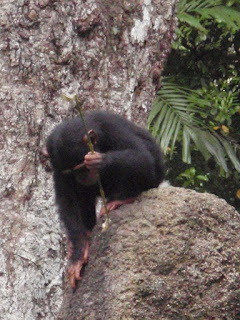Fort Canning hill was originally known as Bukit Larangan prior to the arrival of Sir Stamford Raffles in 1819. Bukit Larangan which means "Forbidden Hill" in Malay. was believed to be the site of palaces built by their ancestral kings. The Keramat Iskandar Shah at the foot of the hill was believed to be the resting place of the last Malay king of the island, and was venerated by Muslims.
Source: Wiki

You can find some interesting exhibits displayed in the Fort Canning Centre. An example is the Congkak game which I used to play in neopets. Geez I did not know it is a traditional game played in the island of Borneo, Singapore, and Peninsular Malaysia (cited in wiki). Neopets actually turned it into a flash version, cool right? Haha.
And did you know that saga seeds can be eaten? You can fry it like peanuts. Yummy?
The seeds were roasted before eating. Elsewhere they are boiled. In Java, they are roasted, shelled, then eaten with rice. They are said to taste like soy bean. The raw seeds are toxic and may cause intoxication. Studies show the cooked seed to be rich in oil and proteins and easily digested by both humans and livestock.
Source: http://www.4to40.com/encyclopedia/index.asp?id=407
Suddenly I felt it is such a waste to see these seeds littered on the roads.

At the start of the tour, a guide demonstrated how to make Bunga Rampai, before proceeding to give each of us a Bunga Rampai. It is actually potpourri made from shredded pandan leaves and flower, sprinkled with rosewater and wrapped up with a perfect betal leaf using either bamboo stick (olden times) or staple (modern technology). Surprised to hear betal leaf can be perfect? It meant the veins must match. With all due respect, I wonder if this is human's doing to seek perfection in all things. Afterall giving a bunga rampai signifies that all things beautiful and desirable will be showered upon the couple.

Pretty and nice smelling :) Oh and thanks for my friend's pose.
We started the tour in the 14th century walk. There is also a 19th century walk which I planned to visit the next round. While walking, the tour guide heard the white belly sea eagle call. I'm always impressed with how people can distinguish all these when I'm already having problem remembering names.

Petai (Parkia speciosa) also known as stink beans, is often eaten raw or blanched and almost always eaten with sambal (chili paste). It is believed to whet one's appetite. Blanching it removes the poisonous substances in addition to removing the smell.

Banana is a shrub! Just reminding myself.
And did you know the squirrels here will eat durians haha.

Kacip fatimah (Labisia pumila)
A popular traditional medicine used for women at childbirth, to help expedite labour and during confinement. A decoction is used to treate flatulence, dysentery and rheumatism.
This is a gender specific plant with the female having 3 black dots (as shown in photo) and the male 2 dots.

If I did not remember wrongly, these are wild cinnamon or cassia. Closely related to the cinnamon, cassia is the cheaper version.

Can you see the cocoa being eaten hollow? Haha

The saviour - lemon grass. It contains citral, which also provides the dominant flavour in lemon peel. Citral has mild insect-repellent properties. Lemon grass is also believed to relieve flatulence.

Did you know that Henna (Lawsonia inermis) is edible too. It is able to cure internal wound if you take it 7 days. However for consumption, the method of preparation is extremely important. Also, the fragrant white flowers can allay fever and dull alertness while the leaves are used to colour medicine.
For me, I only know henna is best known for the dye derived from ground leaves and young shoots. You probably need to ask the Jamu experts on the topic of consumption to know more.

Rice - a type of grass grows best when submerged in water. Seeing this reminds me of my childhood song...
Planting rice is never fun.
Bent from morning till the set of sun.
Can not stand and can not sit.
Can not rest for a little bit.

Nutmeg!

Jamu is an ancient art of healing with the use of concoction of herbs. Traditionally, this art was passed down from mothers to daughters and now, jamu can be found in drinks, pills, capsules and powders.
Jamu encourages the body to produce its own antibodies rather than killing the infection and can be used on its own or in conjunction with other healing techniques such as massage.
The numerous ingredients in a jamu consists of three categories: the main ingredients, supporting ingredients and those added to improve taste.
Hmm the only concoction I took note of is this: egg yolk + honey + turmeric
Tumeric (one of the main ingredients of jamu) extract mixed with egg yolk and honey makes a simple homemade remedy for clearing chest inflammations and phlegm.
And I repeat that I am not taking any responsibility for the consumption and the practise of jamu. If you really want to know more about Jamu, it is best to find an expert who has been practising it for years.


























